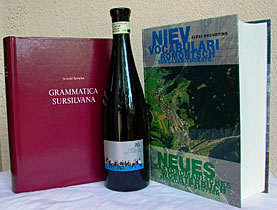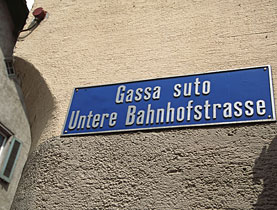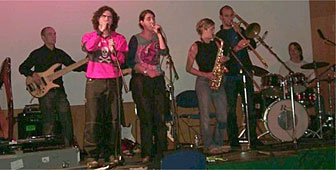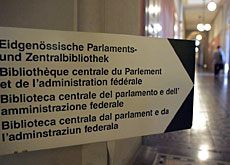Getting to grips with Romansh

"Co has ti num?" a classful of adults diligently ask each other; after some hesitation swissinfo.ch's correspondent manages: "Jeu hai num Julia".
Learning the Sursilvan dialect, or “idiom”, of Switzerland’s fourth language, Romansh, may not be everyone’s idea of a summer holiday, but the course in the village of Laax, celebrated its 40th anniversary in 2009 and many of its students come back year after year. It must be doing something right.
Theodor Brunner, now in his mid-70s, has attended every year since 1995 and is fluent.
“I wanted to learn a new language, and realised that I didn’t yet know all four of Switzerland’s national languages,” he explained to swissinfo.ch.
The oldest participant was Annamaria Mühlethaler – although no-one would guess from looking at her that she is 81. Perhaps learning Romansh has helped.
“I thought that at my age I should do something with my brain, to prevent Alzheimer’s, so I decided to learn the fourth national language,” she said.
She has worked her way up to the seventh class and is definitely coming back next year to repeat it, since the grammar was quite tough.
“After things like “I’d like”, or “I expect” you have to use the subjunctive, or else it’s wrong. People will understand, but it’s important to me to speak correctly,” she explained.
Enthusiasts
Craig Rowland had come from Canada, travelling further than anyone else. It was his fourth course and he found a warm welcome: half the participants already seemed to know him. Not having anyone at home to practise with, he keeps up his knowledge by exchanging Romansh emails with previous fellow-students and teachers.
“People may collect baseball cards, or stamps; I collect the minority languages of Europe,” he told swissinfo.ch. As soon as the course ended, he was off to France to enrol in a Breton class.
However, most of the participants have some connection with the area: many have bought holiday homes there, or are married to a Romansh speaker, or have Romansh roots.
Tessa Meuter, who teaches business English, bought a house in the village of Cumbel about ten years ago, and was attending the course for the first time – but not the last, she was sure.
“People in our village are so nice, they are trying so hard to integrate us. I felt it was just fair to try and learn their language and be able to talk to them in Romansh – at least small talk,” she explained.
Integration
That’s exactly what Francestg Friberg, the course director, wants to hear.
“One important goal of the course is to help people who move here to assimilate, if they want to,” he told swissinfo.ch.
The increased presence of German-speaking incomers threatens the language, he believes. But he doesn’t see any resentment among the local people.
“Perhaps that’s the reason why we switch so quickly over to German. If people weren’t so welcoming, perhaps our language wouldn’t be under so much threat,” he said.
Assimilation is not the only aim of the course, however. Another is to make Romansh better known within Switzerland and Europe.
That’s an aim that Salvatore Stagliano, who taught one of the beginners’ classes, fully supports.
“Sometimes you are in Zurich speaking Romansh, and people think it’s some foreign language. They really ought to be able to recognise, maybe from the pronunciation, that it’s Romansh and not Russian or something like that.”
Conradin Klaiss, the day-to-day manager of the course, has yet another reason for devoting so much of his time and energy to the language.
“I don’t do it to ‘save Romansh’; I just do it because I like my language and want to share it with others.”
Forty years on
The course has changed considerably since its beginnings in 1969.
It was initiated by two dynamic brothers, Flurin and Augustin Maissen. Pader Flurin, as he is usually known, was a Benedictine monk whose enthusiasms ranged from the Romansh language, to geology to renewable energy. Augustin was professor of “medium and minor Romance languages” in a US university.
The original idea was to provide an introduction to Romansh for academic specialists. The first course had 22 participants, mainly from North America, but also from Scandinavia and several eastern European countries. It was held in a small house in the village of Rumein, which belonged to the Benedictines.
Magdalena Popescu-Marin first came in 1974, when she was a researcher at an institute for Romance languages in Bucharest. She was introduced to Romansh by Augustin Maissen, in Romania on an academic visit. She was soon translating Romansh books with the help of a dictionary, so was already conversant with the language when Maissen arranged a scholarship for her to attend a course.
“We had lessons in the dining room in Pader Flurin’s house in Rumein. There weren’t many of us, and just one level. There were two or three teachers. It was like a family,” she recalled.
With 85 participants and eight levels, the course has exploded, but there is still something of a family atmosphere. Conversation over meals ranged from progress reports on a new grandchild to discussions about whether Finnish is more difficult than Hungarian.
While some students complain jokingly that Romansh is so full of exceptions that the rules are simply there to be broken, others are delighted to find that not only does it have a special verb meaning “to falsify animals’ ear tags”, but that this verb is irregular into the bargain.
Catering for all tastes cannot be easy – but finding students who were not happy with the course and pleased with their progress was next to impossible.
Julia Slater in Laax, swissinfo.ch
The Sursilvan summer course is organised by the Fundaziun Retoromana Pader Flurin Maissen (FFR).
It is held for two weeks in July in the village of Laax.
There are now eight levels, from beginners to advanced. The languages of instruction are Romansh and German.
In addition to language lessons, the course includes singing sessions and lectures.
In 2009 there were 85 participants, including 30 beginners. Most were Swiss German speakers; five were from outside Switzerland.
They ranged in age from 16 to 81.
Summer courses are available for the other Romansh idiomas as well: details are published on the site of the Lia Rumantscha.
Latin is the common parent of all the Romance languages.
The most widely spoken are Spanish, Portuguese, French and Italian. They also include Catalan and Romanian.
Like the first three of the above, Romansh is a western Romance language, but belongs to its own Rhaeto-Romance group.
Romansh is spoken in a number of different areas in the southeastern canton of Graubünden.
The main relatives of Romansh outside Switzerland are Friulian and Ladin (spoken in northeastern Italy).
Romansh is divided into five main dialects or “idioms”, each with its own subdialects.
“Romontsh Sursilvan”, as it calls itself, is spoken in Surselva, the valley of the Vorderrhein west of Laax; it is the largest of the Romansh idioms.
In the 2000 census, 66% of the population of the Surselva area said Sursilvan was the language they knew best.
In the same census 78.5% of those in the region said Romansh was the language spoken at home, school and/or work.
In Switzerland as a whole 0.5% of the population – 35,000 people – named Romansh as their best language.

In compliance with the JTI standards
More: SWI swissinfo.ch certified by the Journalism Trust Initiative




You can find an overview of ongoing debates with our journalists here. Please join us!
If you want to start a conversation about a topic raised in this article or want to report factual errors, email us at english@swissinfo.ch.